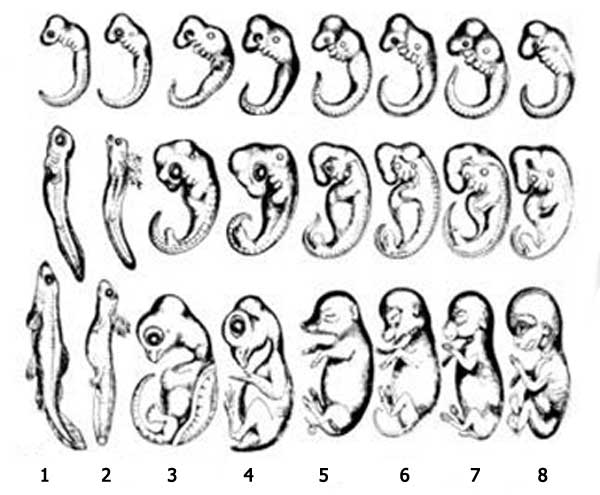The theory of recapitulation, first proposed by Ernst Haeckel towards the end of the 19th century, claimed that during their embryological development, living things repeated the evolutionary process experienced by their forerunners.
He suggested, for example, that during its development in its mother's womb, the human embryo exhibited first fish-like and then reptilian features, before finally becoming human. Subsequently, however, it emerged that this theory was totally a figment of the imagination. In fact, Haeckel himself confessed to the frauds he had perpetrated in the illustrations he produced to support this imaginary scenario. The fact that some evolutionists still give credence to Haeckel's imaginary scenario, and the illustrations that he admitted were fraudulent, shows how far they have lagged behind the scientific literature.
Ernst Haeckel:
After this compromising confession of "forgery," I should be obliged to consider myself condemned and annihilated if I had not the consolation of seeing side by side with me in the prisoner's dock hundreds of fellow-culprits, among them many of the most trusted observers and most esteemed biologists. The great majority of all the diagrams in the best biological textbooks, treatises and journals would incur in the same degree the charge of "forgery," for all of them are inexact, and are more or less doctored, schematisized and constructed. 412
| Haeckel's Fake Drawings | |||
  | |||
| 1. Fish 2. Salamander | 3. Tortoise 4. Chick | 5. Hog 6. Calf | 7. Rabbit 8. Human |
| Haeckel's aim in preparing this imaginary picture was to give the impression that living things are descended from one another. But in doing so, Haeckel perpetrated a fraud. In order to be able to point to a similarity among embryos that actually bore no resemblance to one another, he added imaginary sections to them, or else removed others. Haeckel's theory of recapitulation maintained that during the developmental process, living embryos repeated the evolutionary process undergone by their ancestors. He suggested, for example, that in its mother's womb, a human embryo first exhibited fish-like gills, followed by reptilian characteristics, before finally turning into a human being. Later years, however, showed that this scenario was utterly imaginary. The supposed gills that appear during the earliest stages of development actually turned out to be the middle ear canal and the beginnings of the parathyroid and thymus glands. Another part of the embryo, equated with a fish's yolk sac was revealed to be a sac that produces blood for the baby. That part described as the tail by Haeckel and his followers is in fact the human backbone and resembles a tail only because it develops before the legs. Evolutionists now describe this hoax committed by Haeckel as one of the worst frauds in biology. | |||
George Gaylord Simpson professor of zoology at Columbia University:
Haeckel misstated the evolutionary principle involved. It is now firmly established that ontogeny does not repeat phylogeny.413
From an article in American Scientist:
Surely the biogenetic law(theory of recapitulation) is as dead as a doornail. It was finally exorcised from biology textbooks in the fifties. As a topic of serious theoretical inquiry it was extinct in the twenties...414
From an article in Science magazine:
The impression [Haeckel's drawings] give, that the embryos are exactly alike, is wrong, says Michael Richardson, an embryologist at St. George's Hospital Medical School in London.... So he and his colleagues did their own comparative study, reexamining and photographing embryos roughly matched by species and age with those Haeckel drew. Lo and behold, the embryos "often looked surprisingly different."
Not only did Haeckel add or omit features, Richardson and his colleagues report, but he also fudged the scale to exaggerate similarities among species, even when there were ten-fold differences in size. Haeckel further blurred differences by neglecting to name the species in most cases, as if one representative was accurate for an entire group of animals. In reality, Richardson and his colleagues note, even closely related embryos such as those of fish vary quite a bit in their appearance and developmental pathway. "It [Haeckel's series of drawings] looks like it's turning out to be one of the most famous fakes in biology,' Richardson concludes.415
From an article in New Scientist:
[Haeckel] called this the biogenetic law, and the idea became popularly known as recapitulation. In fact, Haeckel's strict law was soon shown to be incorrect. For instance, the early human embryo never has functioning gills like a fish, and never passes through stages that look like an adult reptile or monkey.416
412- Francis Hitching, The Neck of the Giraffe: Where Darwin Went Wrong, New York: Ticknor and Fields , 1982, p. 204.
413- G. G. Simpson, W. Beck, An Introduction to Biology, New York: Harcourt Brace and World, , 1965, p. 241.
414- Keith S. Thomson, "Ontogeny and Phylogeny Recapitulated," American Scientist, Vol. 76, May/June 1988, p. 273.
415- Elizabeth Pennisi, "Haeckel's Embryos: Fraud Rediscovered," Science, 5 September, 1997.
416- Ken McNamara, "Embryos and Evolution," New Scientist, vol. 12416, 16 October 1999.